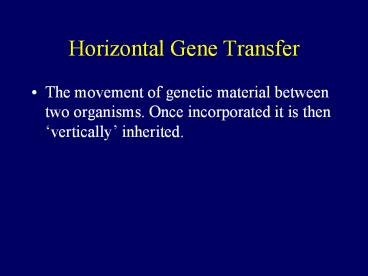Horizontal%20Gene%20Transfer - PowerPoint PPT Presentation
Title:
Horizontal%20Gene%20Transfer
Description:
Transformation- naked DNA, short pieces, common in bacteria that transform ... Scope of HGT in bacteria. 19 Complete genomes across wide phylogenetic lines ... – PowerPoint PPT presentation
Number of Views:463
Avg rating:3.0/5.0
Title: Horizontal%20Gene%20Transfer
1
Horizontal Gene Transfer
- The movement of genetic material between two
organisms. Once incorporated it is then
vertically inherited.
2
HGT in Eukaryotes
- Eukaryotes - membrane bound, nucleus
- Exchange of genetic material during sexual
reproduction - Recombination
3
One other instance of HGT in Euks
- Endosymbiosis, happened at least 2 billion years
ago. - Transfer of genes from mitochondria, plastids to
nuclear genome over that time - Mitochondria have about 40 genes
- Plastids have about 120 genes
4
Figure 2 Phylogenetic distribution of gene loss
from chloroplast genomes. Colour keys designating
frequency of parallel gene losses are given at
top right. Numbers below species names indicate
the number of proteincoding genes and ycfs in the
corresponding chloroplast genome. Numbers above
gene columns represent thenumber of genes lost
which are accounted for in the figure for the
given genome. The symbols for primary and
secondary symbiosis are indicated. Five genes
were excluded from gene-loss analysis for reasons
indicated at the lower left. Some highly
divergent proteins may have escaped detection
with BLAST searches. Functional, transferred
nuclear homologues of chloroplast origin are
indicted in white rectangles. In Pinus, four ndh
genes are completely missing (ndhA, ndhF, ndhG,
ndhJ), the other seven are pseudogenes23 and are
scored as losses here.
Martin et al, Nature, 1998
5
Horizontal Gene Transfer
- The movement of genetic material BETWEEN
prokaryotes - Common in prokaryotes. Useful for environmental
adaptation (better than point mutations)
Doolittle, 1997
6
Prokaryotes
- Different kind of cell organization
- Sex as you dont know it
7
Horizontal Gene Transfer
- Also called Lateral Gene Transfer
- HGT and LGT for short
- 3 ways to do it
- Transformation- naked DNA, short pieces, common
in bacteria that transform - Clay 28 hrs ocean surface - 45-83 hrs ocean
sediment-235 - Transduction phage, donor/recipient share
receptors, closely related bacteria, DNA amount
in phage head - Conjugation-plasmids/transposons, cell to cell
contact, distant relations, long DNA
8
Known Instances of HGT
- Antibiotic resistance genes on plasmids
- Insertion sequences
- Pathogenicity islands
- Toxin resistance genes on plasmids
- Agrobacterium Ti plasmid
- Viruses and viroids
- Organelle to nucleus transfers
9
(No Transcript)
10
Requirements for Transfer Proximity to donor
DNA Stability of DNA in environment Vector
transmission Uptake and insertion Maintenance S
tabilization Selection
What Limits/Prevents Transfer Instability in new
host Restriction systems GC/Codon usage
incompatibility Splicing and other signals
incorrect RNA editing Lack of appropriate
interacting genes
11
The question how much HGT really goes on?
- Rare going from prokaryotes into multi celled
euks because must go into egg/sperm - Exception is mitochondria, plastids
- Instances of Euks -gtProks ?!?!
- How often does it happen in proks?
12
Lateral Gene Transfer and the nature of bacterial
innovationOchman, Lawrence, and Groisman, Nature
405299-304
- Single celled organism, genome varies only by an
order of magnitude. - Narrow taxonomic groups, phenotypic diversity is
remarkable. - Usually have a unique set of physiological
characters to define its particular ecological
niche.
13
(No Transcript)
14
How can you detect HGTs?
- DNA sequence information
- Phylogenetic trees
- GC Content
- Codon bias
- Sequences new to a genome will retain (for a
while) the signatures of the donor genome and
distinguished from ancestral DNA
15
Comparing a gene tree with the rRNA tree
16
GC Content
- DNA is double stranded, G pairing with C
- Measure the amount of GC content in regions
- If one region varies from most of the genome,
than likely HGT
52 47 52
17
Codon Usage
18
(No Transcript)
19
(No Transcript)
20
Bacterial recombination
- It does happen
- The action of bacterial mismatch correction
systems greatly reduces the efficiency of
homologous recombination - Must be closely related DNA then
- Affects existing genes, not than unique traits
- No big role in ecology and physiology
21
Scope of HGT in bacteria
- 19 Complete genomes across wide phylogenetic
lines - ORFS whose sequence characteristics depart from
the resident genome
22
(No Transcript)
23
Length of bars represent amount of coding DNA,
native is blue, Foreign due to mobile elements
is yellow, other is red. Numbers Are the of
foreign DNA
Ochman, et al 2000
24
Rate of Sequence acquisition
- In E. coli examined he amelioration of atypical
sequence characters (eg nucleotide composition)
towards equilibrium values in the genome - Estimation of time of arrival for each segment of
foreign DNA - 16 kb per million year
25
What about GM?!
- Transgenes differ from native genes
- They contain DNA seq homology to proks so can be
integrated widely. - Modified for broad expression in variety of hosts
- Regulation elements that work across a broad
range of hosts. - No extensive interactions.
- BUT do these provide a genetic variability that
is advantageous?































